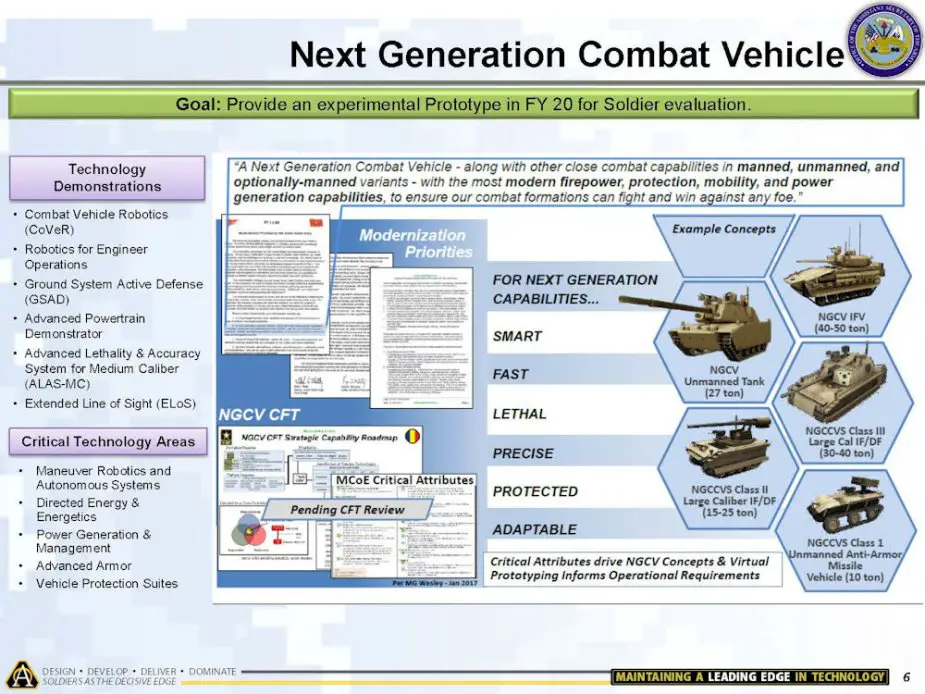In 2018, the U.S. Army stood up the service's newest command to drive innovation. Since that time, Army Futures Command has become fully operationally capable and complements the other Army commands, Forces Command, Training and Doctrine, and Army Materiel Command, as the cornerstone of the Army's modernization efforts. Phillip B. Fountain, U.S. Army Futures Command, reports on U.S. Army’s website.

Next-Generation Combat Vehicles are one of the six U.S. Army's priorities (Picture source: U.S. Army)
AFC has senior leaders from across the command scheduled to participate in several events throughout the Association of the U.S. Army's annual conference, which is scheduled to be held, Oct. 14-19, in Washington. "The Army must modernize today or we could lose the next war," wrote the Secretary of the Army Ryan D. McCarthy, in his first letter to the force, dated Sept. 27, 2019. "We will remain focused on delivering the 31 signature systems our cross-functional teams are developing in support of the six modernization priorities and ensure we can employ them the day they show up."
The Army's six modernization priorities are: Long-Range Precision Fires; Next-Generation Combat Vehicles; Future Vertical Lift; The Network; Air & Missile Defense; and Soldier Lethality. To achieve this, AFC leads the following eight cross-functional teams: Air and Missile Defense (Fort Sill, Oklahoma); Assured Positioning, Navigation and Timing (Redstone Arsenal, Huntsville, Alabama); Future Vertical Lift (Redstone Arsenal, Huntsville, Alabama); Long-Range Precision Fires (Fort Sill, Oklahoma); Network (Aberdeen Proving Ground, Maryland); Next-Generation Combat Vehicle (Detroit Arsenal, Warren, Michigan); Soldier Lethality (Fort Benning, Georgia); and Synthetic Training Environment (Orlando, Florida).
Gen. John M. Murray, AFC's commanding general, is slated to join Dr. Bruce Jette, the assistant secretary of the Army for acquisition, logistics and technology (ASA(ALT)), in an AUSA Contemporary Military Forum titled, Delivering Force Modernization. Jette and Murray are expected to discuss how the Army is becoming a continually modernizing organization and the ways AFC and ASA(ALT) are working together to foster change and embrace accountability in order to enable the accelerated fielding of technological capability to Soldiers in the field.
Since last year, the two organizations will be able to highlight major achievements, including the initial fielding of the Enhanced Night Vision Goggle-Binocular (ENVG-B) to Soldiers of the 2nd Brigade Combat Team, 1st Infantry Division at Fort Riley, Kansas. The ENVG-B is the first day/night capable heads-up display for the dismounted maneuver force. It is expected to increase lethality, situational awareness, and mobility required to defeat combat threats in any environment.
But this is not the only success to be touted. AFC has built momentum and is closely working with ASA(ALT) and other partners. These public and private partners include hundreds of colleges and universities, and nearly 1,500 companies, from four-person start-ups to major corporations.
Those attending will have an opportunity to hear it directly from Murray. He is expected to also discuss how the command got to full operational capability within the first year, as well as how AFC is leveraging the strength of academic and intellectual freedom to position Army modernization in a way to win the fight before an actual fight.















